hood open AUDI A5 CABRIOLET 2011 Owners Manual
[x] Cancel search | Manufacturer: AUDI, Model Year: 2011, Model line: A5 CABRIOLET, Model: AUDI A5 CABRIOLET 2011Pages: 364, PDF Size: 86.48 MB
Page 11 of 364
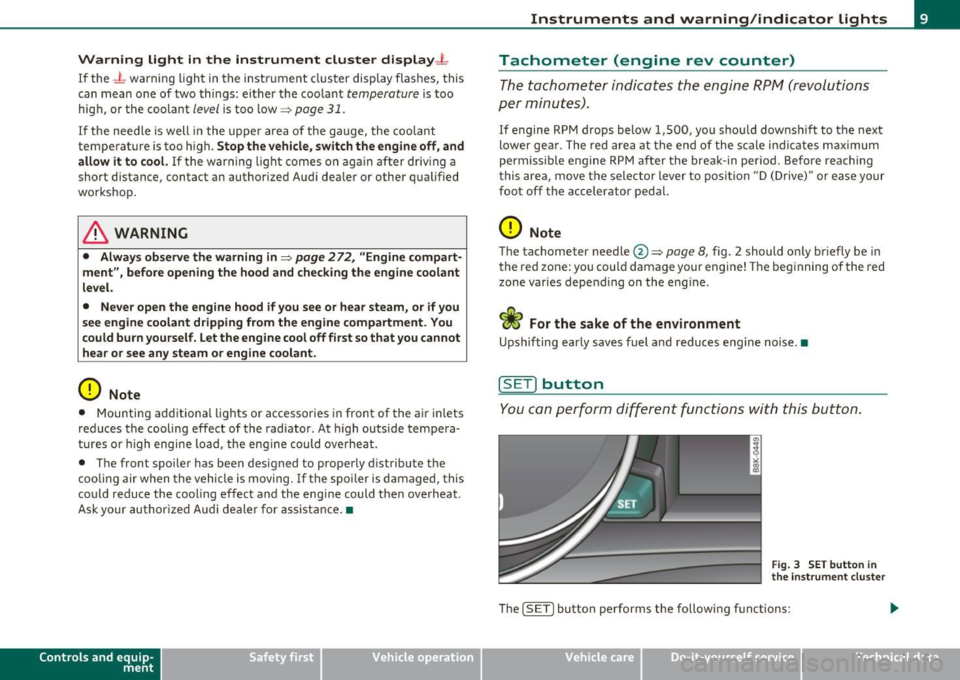
Warning light in the instrument cluster display-1-
If the _L warning light in the i nstrument clus ter display flashes, this
can mean one of two things: either the coo lant
temperature is too
high, or the coolant
level is too low ~ page 31 .
If the needle is well in the uppe r area of the gauge, the coo lant
temperature is too high.
Stop the vehicle, switch the engine off, and
allow it to cool.
If th e war ning light comes o n ag ain af ter driv ing a
short distance, contact an author ized Aud i dea ler or othe r qualified
wor ksh o p.
& WARNING
• Alway s observe the warn ing in :::} page 272, "Engine compart·
ment ", before opening the hood and checking the engine coolant
level.
• Never open the engine hood if you see or hear steam, or if you
s ee engin e coolant dripping from the engine compartment. You
could burn yourself . Let the engine cool off first so that you cannot
hear or see any steam or engine coolant .
0 Note
• Mounting add ition al lights o r accesso ries in fron t of the a ir inlets
reduces the cooling effect of the radiator . At high outside tempera
tur es o r high engine load, the eng ine could ove rhe at.
• The front spo iler has been designed to properly d istribute the
c oo lin g air when the vehicle is moving. If the sp oi ler is d amaged, this
co uld reduce the cooling eff ect and the eng ine could then overheat .
Ask your au thor ized A udi dealer for assis tance .•
Con tro ls a nd e quip
m en t Vehicle
OP-eration
Instruments and warning /indicator lights
Tachometer (engine rev counter)
The tachomete r in dic ates t he engine RPM (revoluti ons
pe r mi nutes) .
If engine RPM drops below 1,500, you shou ld downsh ift to the next
lower ge ar. T he red area at the end of the s cale i ndi cates max imum
permissible engine RPM after the brea k-in per iod. Before reaching
t his area, move t he selector lever to po sition "D (Dr ive)" or ease yo ur
foot off t he accelerator pedal.
0 Note
T he tachometer needle @~ page 8, fig. 2 should o nly br iefly be in
t he red zone: yo u co uld damage your eng ine! T he beg inning of the red
zone varies depe nd ing o n the eng ine.
~ For the sake of the environment
Upshifting early saves fuel and redu ces engine noise .•
[S ET] button
You c an per form d iffere nt fu nctions with t his but ton.
Fig . 3 SET butto n in
the instrume nt clu ste r
Th e !SE TI bu tto n performs the fo llow ing f unct io ns:
Vehicle care Do-it-yourselt service iTechnical data
Page 22 of 364
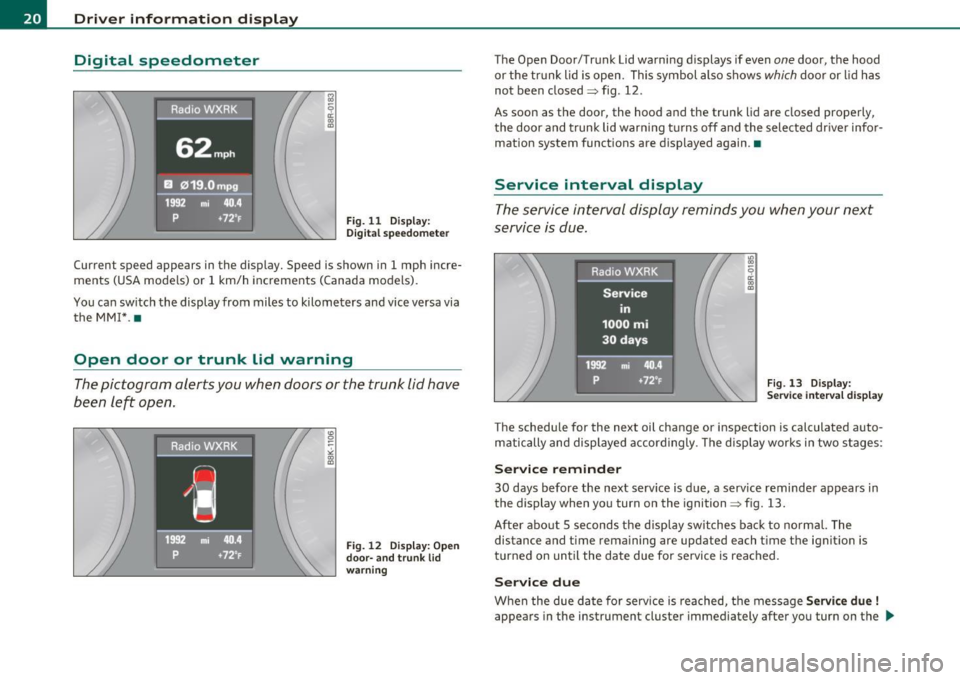
Driver information displ ay
Digital speedometer
Fig. 11 Display:
Di gital speedomet er
Current speed appears in the display. Speed is shown in 1 mph incre
ments (USA models) or 1 km/h increments (Canada models).
You ca n sw itch the display from miles to kilometers and vice versa via
the MM! *.•
Open door or trunk lid warning
The pictogram alerts you when doors or the trunk lid have
been left open.
Fig. 12 Disp lay : O pen
door- and tr unk li d
w arni ng
The Open Door/Trunk lid warning d isplays if even one door, the hood
or the trunk lid is open. This symbol also shows
which door or lid has
not been closed=> fig. 12.
As soon as the door, the hood and the trunk lid are closed properly, the door and trunk lid warn ing tu rns off and the selected dr iver info r
mation system functions are displayed again .•
Service interval display
The service interval display reminds you when your next
service is due.
Fig. 13 Display:
S ervic e in te rva l d isp lay
The schedule for the next oil change or inspection is calculated auto
matically and displayed accordingly . The disp lay works in two stages :
Service remind er
30 days before the next serv ice is due , a serv ice reminder appears in
the display when you turn on the ignition=> fig. 13.
After abo ut S seconds the d isp lay switches back to norma l. The
distance and time remaining are updated each t ime the ignition is
turned on until the date due for service is reached.
Ser vice due
When the due date for service is reached, the message Servic e due !
appears in the instrument cluster immediately after you turn on the ..,,
Page 32 of 364

Driver information display
you have to stop immediately and turn off the engine. The coolant
pump is not working anymore--danger of damage to the engine! •
Brake system malfunction
A malfunction in the brake system must be repaired as
soon as possible.
If the warning/indicator light BRAKE (USA models)/ ((D)
(Canada models) in the instrument cluster flashes, there is a
brake system malfunction . A driver message appears as well
to explain the malfunction in more detail. The driver warning
goes out after about S seconds, but it can be brought up at
any time by pressing the
!SET] button again.
Stop the Vehicle and Check the Brake Fluid
- Stop the vehicle.
-Check the brake fluid level=>
page 289.
- Seek professional assistance if necessary .
Warning ! Fault in brake system. Contact
workshop
- Drive carefully to the nearest authorized Audi dealer or other qualified workshop and have the malfunction
corrected =>
&.
Parking brake Please get to a repair shop
- If this symbol appears when the vehicle is stationary or
after the ignition is turned on, check to see if the parking brake can be released. Drive to an authorized Audi dealer
or other qualified workshop as soon as possible and have
the malfunction corrected. If the parking brake cannot be
opened, then take it to an expert at an authorized Audi
dealer.
- If the symbol appears while you are driving, it is possible that the traction control or the emergency brake has malfunctioned. It is possible that the parking brake
cannot be applied. It is also possible that the parking
brake cannot be released after it has been applied. Drive
to an authorized Audi dealer or other qualified workshop
to have the malfunction corrected.
If the ABS system malfunctions, the ABS warning/indicator light illu
minates together with the brake system malfunction warning/indi
cator light~& .
& WARNING
• Always observe the warnings in~ page 2 72, "Engine compart
ment", before opening the hood and checking the brake fluid.
• Driving with low brake fluid is a safety hazard. Stop the car and
get professional assistance.
• USA models: If the BRAKE warning light and the i, warning
light come on together, the rear wheels could lock up first under
hard braking. Rear wheel lock-up can cause loss of vehicle control
and an accident . Have your vehicle repaired immediately by your
authorized Audi dealer or a qualified workshop. Drive slowly and
avoid sudden, hard brake applications.
• Canada models: If the brake warning light (CD) and the ABS
warning light come on together, the rear wheels could lock up .,_
Page 33 of 364

& WARNING (continued)
first under hard braking. Rear wheel lock-up can cause loss of
vehicle control and an accident. Have your vehicle repaired imme diately by your authorized Audi dealer or a qualified workshop.
Drive slowly and avoid sudden, hard brake applications. •
Engine cooling system malfunction -•-
A malfunction in the engine cooling system must be repaired as soon as possible.
If the - t-symbol flashes in the display, either the engine
coolant
temperature is too high or the engine coolant level is
too low. A driver message appears as well to explain the
malfunction in more detail. The driver warning goes out after
about 5 seconds, but it can be brought up at any time by
pressing the
[SET] button again.
Switch off engine and check coolant level
- Pull off the road.
- Stop the vehicle.
- Turn off the engine .
- Check coolant level==>
page 287.
- Add coolant if necessary ==> page 288.
- Continue driving only after the engine coolant
warning/indicator light goes out.
- Contact your authorized Audi dealer for assistance if
necessary .
If the engine coolant level is correct, then the radiator fan may be the
cause of the malfunction.
Controls and equip
ment Safety first
Driver information display
& WARNING
•
If your vehicle should break down for mechanical or other
reasons, park at a safe distance from moving traffic, turn off the
engine and turn on the hazard warning lights=>
page 67, "Emer
gency flashers
A".
• Never open the hood if you see or hear steam or coolant
escaping from the engine compartment· you risk being scalded.
Wait until you can no longer see or hear steam or coolant
escaping.
• The engine compartment of any vehicle is a dangerous area.
Before you perform any work in the engine compartment, turn of
the engine and allow it to cool. Follow the warning stickers
=> page 2 72, "Engine compartment".
0 Note
Do not continue driving if the-~- symbol illuminates. There is a
malfunction in the engine cooling system -you could damage your
engine. •
Engine oil pressure malfunction
immediate service or repair. Driving with a low oil pres
sure indication is likely to cause severe engine damage.
If the 'l=:7: symbol on the display flashes, the engine oil pres
sure is too low. A driver message appears as well to explain
the malfunction in more detail. The driver warning goes out
after about 5 seconds, but it can be brought up at any time by
pressing the
[SET] button again.
Switch off engine! Oil pressure too low
-Stop the vehicle.
Vehicle care Technical data
Page 44 of 364
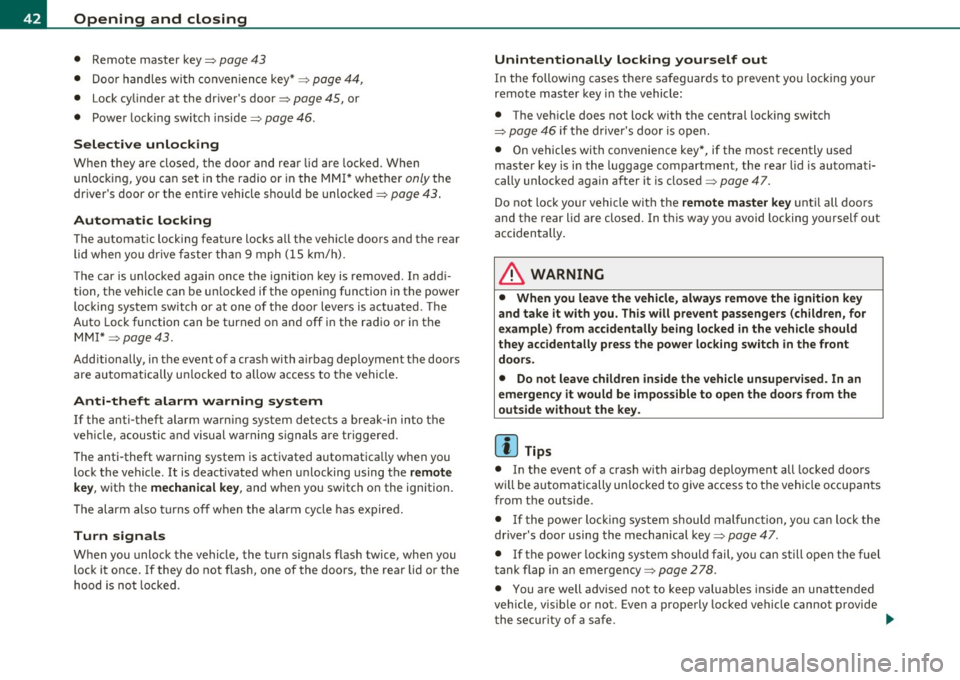
Opening and closing
• Remote master key~ page 43
• Door hand les wi th co nve nien ce key* ~ page 44,
• Lock cyli nder at the dr iver's door~ page 45, or
• Power locking swi tch inside~
pag e 46.
Selective unlocking
When they are closed, the door and rear lid are locked. When
unloc kin g, you ca n set in the radio or in the MMI* whethe r
only the
dr iver 's door or the entire veh icle s hou ld be unlocked~
page 43.
Automatic locking
The automat ic lock ing feature locks all the vehicle doors and the rear
lid when you d rive f aster th an 9 mph (15 km/h).
The car is unlocked agai n once t he ignition key is removed . In add i
tion , the vehicle can be u nlocked if the open ing function in the power
loc king system switch o r at one of th e door levers is a ctuated. The
Auto Lock function can be turned o n and off i n the ra dio or in the
MMI * ~ page 43.
Add itionally, in the event of a crash with a irbag deployme nt the doors
are au tomatically u nlocked to allow access to the vehi cle.
Anti-theft alarm warning system
If the anti -the ft ala rm warn ing sys tem detec ts a break -in into t he
vehicle, acoustic and v isual warning s ignals are triggered .
T he anti-theft warning system is activated a utomat ica lly when you
lock the vehicle . It is deactivated w hen u nlocking using the
remote
key ,
with the mechanical key , and when you switch o n the ignition.
Th e alarm also turns off whe n the alarm cycle has ex pire d.
Turn signals
W hen you unlock the vehicle, the t urn s ignals f lash twice, when you
loc k it once. If they do not flash, one of the doors, the rear lid or the
hood is not locked .
Unintentionally locking yourself out
In the following cases the re safeguards to prevent yo u locking yo ur
remote maste r key in the vehicle:
• The veh icle does not lock with the central lock ing switch
~ page 4 6 if the d rive r's doo r is open.
• On vehicles with convenience key*, if the most recently used
maste r key is in the luggage compartment , th e re ar lid is au tomati
cally unlocked again after it is closed
~ page 47.
Do not lock yo ur vehicle wi th the remote master key u nti l all doo rs
and the rear lid are closed. In th is way you avoid locking yourself out
accidentally .
& WARNING
• When you leave the vehicle, always remove the ignition key
and take it w ith you. This will prevent passengers (children, for
example) from a ccidentally being locked in the vehicle should
they accidentally press the power locking switch in the front doors.
• Do not leave children inside the veh icle unsupervised. In an
emergency it would be impossible to open the doors from the
outs ide w ithout the key .
W Tips
• In the event of a cras h w it h ai rbag deployme nt all locked doo rs
w ill be a utomat ically un locked to give access to the vehi cle o ccupants
from the outside .
• If the power lo cking system should mal func tion, you c an lock the
dr iver 's door using the mechanical key~
page 47.
• If the power locking sys tem sho uld fail, yo u ca n s till open t he fuel
tank flap in a n emergency ~
page 278.
• You a re well advised not to keep valuables i nside a n un attended
vehicle, v isib le or not. Even a properly locked vehicle cannot provide
t he se cu rity of a sa fe. .,_
Page 46 of 364
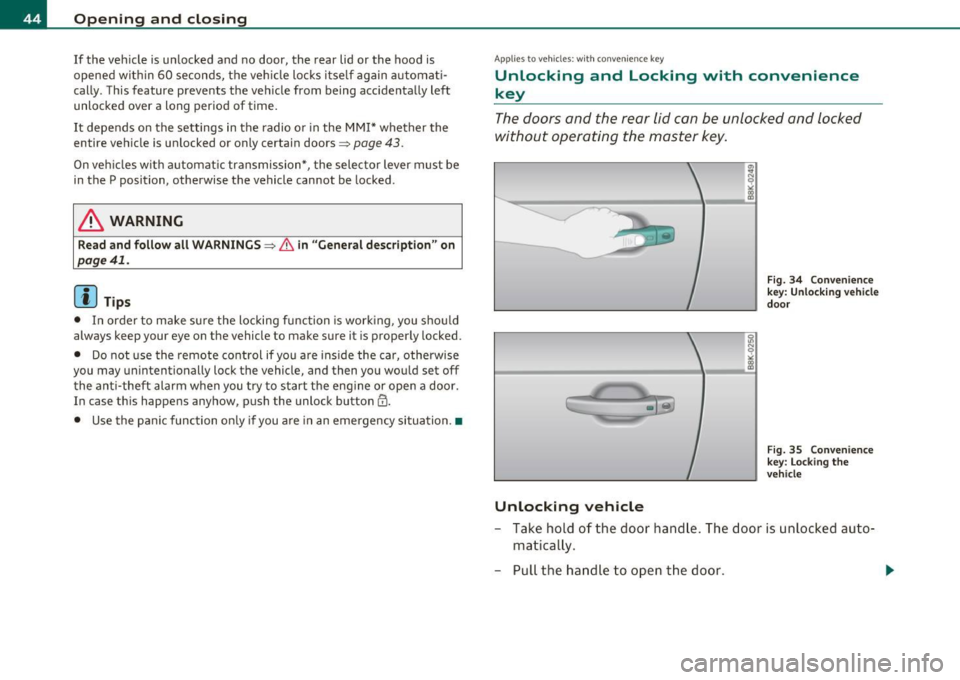
Opening and closing
If the vehicle is unlocked and no door, the rear lid or the hood is
opened within 60 seconds, the vehicle locks itself again automati
cally. This feature prevents the vehicle from being accidentally left
unlocked over a long period of time.
It depends on the settings in the radio or in the MMI* whether the
entire vehicle is unlocked or only certain doors=>
page 43.
On vehicles with automatic transmission*, the selector lever must be
in the P position, otherwise the vehicle cannot be locked.
& WARNING
Read and follow all WARNINGS=> & in "General description" on
page 41.
[ i ] Tips
• In order to make sure the locking function is working, you should
always keep your eye on the vehicle to make sure it is properly locked.
• Do not use the remote control if you are inside the car, otherwise
you may unintentionally lock the vehicle, and then you would set off
the anti-theft alarm when you try to start the engine or open a door.
In case th is happens anyhow, push the unlock button@.
• Use the panic function only if you are in an emergency situation. •
Applie s to vehic les: w ith conven ien ce key
Unlocking and Locking with convenience
key
The doors and the rear lid can be unlocked and locked
without operating the master key.
Unlocking vehicle
Fig. 34 Convenience
key: Unlocking vehicle
door
Fig. 35 Convenience
key: Locking the
vehicle
- Take hold of the door handle. The door is unlocked auto
matically.
- Pull the handle to open the door.
Page 264 of 364
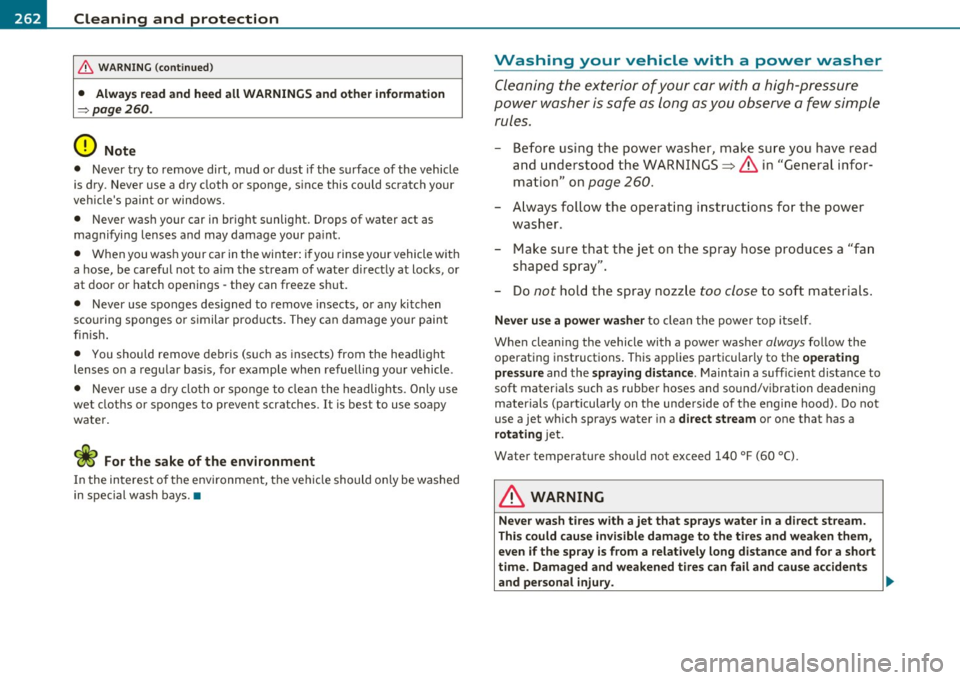
-~_C_ le_ a_n_ i_ n_ g=- a_ n_d___. p_ ro_ t_e _c_ t_ i_o _n ___________________________________________ _
& WARNING (conti nu ed )
• Alway s read and heed all WARNINGS and other information
~ page 260 .
0 Note
• N ever try to remove dirt, mud o r d ust if the su rface of the vehicle
is dry . Never use a dry cloth or sponge, since this could scratch your
veh icle's pai nt or windows.
• Never was h your car in bright sunlight . D rops of water act as
magni fyi ng lenses and may damage your pa int.
• When you was h yo ur c ar in the winter: i f you rinse your vehicle wit h
a hose, be care ful not to a im the stream of wate r d irectly at locks, or
at door or hatch openings -they can freeze shut.
• Never use sponges des igned to remove insects, or any kitchen
s co ur ing sponges or s imilar pro ducts. They can damage your paint
fin ish ,
• You shou ld remove debris (s uch as inse cts) from the he adlight
lenses on a regu lar bas is, for example when refuelling yo ur vehicle .
• N ever use a d ry cl oth o r sponge to clean t he he adlig hts . Only use
wet cloths or sponges to prevent scratches. It is best to use soapy
wate r.
~ For the sake of the environment
In the in terest o f th e envi ronme nt, the ve hicl e should o nly be washed
in special wash bays. •
Washing your vehicle with a power washer
Clea ning the ex teri or of y our c ar with a high- pre ssu re
po wer washer is safe as long as y ou obser ve a fe w sim ple
rul es.
- Before using the powe r washer, make su re you have read
a nd unders tood the WARN IN GS=>
& in "General info r
ma tio n" on
page 260.
- Alw ays fo llow t he operat ing i nst ructions fo r the powe r
washer.
- Make sure t hat the jet o n the spray hose produces a "fa n
shaped sp ray".
- Do
not ho ld t he spr ay no zz le too close t o sof t ma terials .
Never use a power wa sher to cl ean the powe r to p itself.
When cleaning the vehicle with a powe r washe r
always follow the
operat ing inst ruct ions . T his app lies part icu larly to the
operating
pres sure
and the spraying distance. M ain tain a suff ic ient distance to
soft mater ia ls s uch as rubbe r hoses an d so und/v ibration deaden ing
m ater ials (pa rt icula rly on t he un derside o f th e e ng ine hood). Do not
use a jet which sprays water in a
direct stream or one that has a
rotating j et.
Water temperature s hou ld not exceed 140
°F (60 °().
& WARNING
Never wash tires with a jet that sprays water in a direct stream.
This could cause invisible damage to the tires and weaken them ,
even if the spray is from a relatively long distance and for a short
time . Damaged and weakened tires can fail and cause accident s
and personal injury . .,_
Page 281 of 364

___________________________________________ C_ h _ e_c _k _ i_n -=g .._ a_n _ d_ f_i _ll _i _ n -=g '-- ........
Checking and filling
Engine hood
Releasing the engine hood
The engine hood is released from inside the vehicle.
- Open the driver's door.
Fig. 218 Driver's side
footwell : engine hood
release lever
- Pull the release lever on the left under the instrument
panel ::::, fig . 218 in the direction of the arrow.
The hood pops up slightly under spring pressure. •
Vehicle OP-eration
Opening the engine hood
Fig. 219 Release lever
under the engine hood
Before opening the engine hood, make sure that the wind
shield wipers are flat against the windshield. Otherwise, they
could damage the paint on the hood.
Pull up on the release under the hood::::, fig. 219 . This
releases the catch.
- Open the hood all the way::::,& .
& WARNING
Hot engine coolant can burn you.
• To reduce the risk of being burned, never open the hood if you
see or hear steam or coolant escaping from the engine compart
ment. Wait until no steam or coolant can be seen or heard before
carefully opening the hood. •
Vehicle care Do-it-yourselt service iTechnical data
Page 282 of 364

-Checking and filling
-------=------=---------------------------------------------------
Closing the engine hood
-Pull the hood down until the pressure from the struts is
reduced.
- Let the hood
drop down and latch in place . Do not try to
push it shut;
it may fail to engage=> &.
& WARNING
A hood that is not completely latched could fly up and block your
view while driving.
• When you close the engine hood, check it to make sure the
safety catch has properly engaged. The hood should be flush with
the surrounding vehicle body parts.
• If you notice while driving that the hood is not secured prop
erly, stop at once and close it. •
Working in the engine compartment
Be especially careful whenever you work in the engine
compartment.
Whenever you must perform any work in the engine compartment,
for example checking and filling different fluids, there is a risk of
injury, burns and accidents. To prevent personal injury always
observe the following WARNINGS. The engine compartment of any
vehicle is a hazardous area
=> & .
& WARNING
To help avoid injury, before you check anything under the hood :
• Turn off the engine.
• Remove the ignition key.
• Apply the parking brake.
& WARNING (continued)
• Move selector lever of automatic transmission to "P" (Park).
• Always let the engine cool down. Hot components will burn
skin on contact.
• To reduce the risk of being burned, never open the hood if you
see or hear steam or coolant escaping from the engine compart
ment. Wait until no steam or coolant can be seen or heard before
carefully opening the hood.
• Keep children away from the engine compartment.
• Never spill fluids on hot engine components. They can cause a
fire.
• Never touch the radiator fan. The auxiliary electric fan is
temperature controlled and can switch on suddenly.
• Never open the coolant reservoir cap when the engine is still
warm. The coolant system is pressurized and hot coolant could
spray out.
• Protect your face, hands and arm from steam or hot engine
coolant by placing a thick rag over the cap when you open the
coolant reservoir.
• If work on the fuel system or the electrical system is necessary:
-Always disconnect the battery.
- Never smoke or work near heaters or open flames. Fluids in
the engine compartment could start a fire.
- Keep an approved fire extinguisher immediately available.
• To avoid electrical shock and personal injury while the engine is
running or being started, never touch: -Ignition cables
- Other components of the high voltage electronic ignition system.
• If you must perform a check or repair with the engine running: -First, fully apply the parking brake, move selector lever of
automatic transmission to "P" (Park). ..,
Page 286 of 364

•--=C:.:.h.:.. e=. c=.:..:: k .:.:in ..:. g ~ a::..:..: n~d .:...:.. f:....:il ..:.li :.:.n.;.: g~ ------------------------------------------
0 Note
Driv ing with an insufficient o il level is likely to cause severe damage
to the engine .
[ i J Tips
• The oil pressure wa rning display 9:!::r. is not an ind icator of the oil
level. Do not rely on it. Instead, check the oil level
in your engine at
r egula r inte rvals , prefe rably ea ch time you refuel , and always
before going on a long trip.
• If you have the impression your engine consumes excessive
amounts of o il, we recommend th at yo u consult an autho riz ed Aud i
dealer to have the cause of your concern properly diagnosed . Keep in
m ind that the accurate measu rement of oil consumption re quires
great care and may take some t ime. An authorized Audi dealer has
instructions about how to meas ure oil consumption accu rately .•
Checking the engine oil level
Fig. 2 21 MMI D isplay :
Oil le vel ind icat or
Read oil level
-Park your vehicle on a level sur face.
- S hut the engine off when it is warm. -
Switc h only th e ignition back on .
- Wa it appro ximately two minutes.
- Select: Function button
[CAR ]> Oil level.
- Check the oi l level in the display=> fig. 2 2 1. Add e ngi ne oil
if t he ba r of the oil level ind icator is near "min"
=>
page 284 .
The oil leve l needs to be c hec ked at regular intervals. The bes t times
to do this are whe neve r you refuel and p rior to long tr ips.
Depending on the way the vehicle is driven and the operating condi
ti ons, oi l cons ump tion can be u p to 1/2 q uart per 600 m iles (0.5 l iter
per 1,000 km). Consumpt ion may be higher with in the first 3,000
m iles (5,0 00 km).
[ i J Tips
T he oil leve l ind icator in the MM I Display is only an informa tion
display . If the oil level is too low, a minim um oil warning appea rs in
the inst rument cl uster . Add oil=>
page 284 . If th e hood has been
opened, the current oil level is shown in the instrument cluster the
ne xt time the ignition is switched on. •
Adding engine oil ce:i,-:
Fig. 222 Engine
com partment : Oil fill er
c a p l oca tion ...